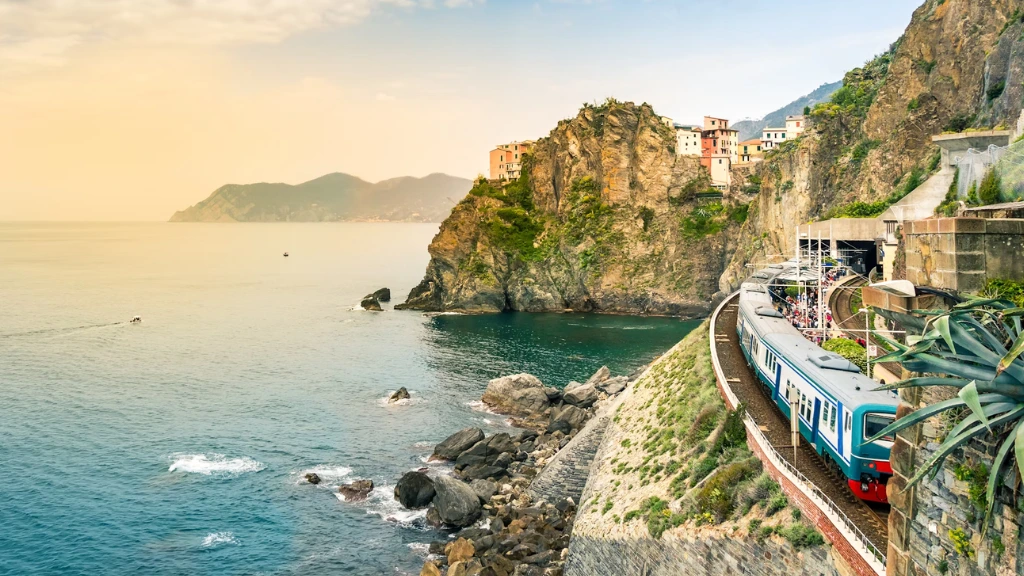Traveling by train is one of the best ways to see Italy. The country’s rail system connects bustling cities, charming towns, and scenic landscapes, making it easy to explore without the hassle of driving.
Whether you’re heading to Rome, Florence, Venice, or the Italian countryside, this guide will help you navigate Italy’s trains with confidence and ease.
You May Also Like: Experience the Magic of Kauaʻi
Why Choose Train Travel in Italy?
Italy’s rail network is well-organized, efficient, and scenic. High-speed trains can take you from one end of the country to the other in just hours, while regional trains connect smaller towns and picturesque countryside. Here are a few reasons why train travel is a great choice:
- Convenience: Italy’s trains connect most major cities and towns. Stations are often centrally located, making them easy to access.
- Scenic Routes: Many train routes offer breathtaking views, from the Tuscan countryside to the Italian Riviera.
- Environmental Benefits: Traveling by train is a greener choice, with fewer emissions than air travel or driving.
- Affordability: Train tickets are often more economical than flights or car rentals, especially if booked in advance.
Types of Trains in Italy
Italy has several types of trains, each serving different needs and routes.
1. Frecciarossa (Red Arrow)
Frecciarossa is Italy’s fastest and most luxurious high-speed train, operated by Trenitalia. It connects major cities like Milan, Rome, Naples, and Venice.
- Top Speed: 300 km/h (186 mph)
- Amenities: Wi-Fi, power outlets, dining car, and quiet car options.
- Classes: Standard, Premium, Business, and Executive.
2. Frecciargento (Silver Arrow)
Frecciargento trains are also high-speed, connecting larger cities with secondary cities like Verona, Bari, and Reggio Calabria.
- Top Speed: 250 km/h (155 mph)
- Amenities: Comfortable seating, onboard Wi-Fi, and refreshments.
3. Frecciabianca (White Arrow)
Frecciabianca trains are high-speed, but they travel on standard tracks rather than dedicated high-speed lines. They connect cities on the Adriatic and Tyrrhenian coasts.
- Top Speed: 200 km/h (124 mph)
- Routes: Popular for coastal cities and towns, including Genoa and Venice.
4. InterCity Trains
InterCity trains are slower but travel between major and mid-sized cities, stopping at more stations along the way.
- Top Speed: 160 km/h (99 mph)
- Cost: More affordable than high-speed trains, with flexible options.
5. Regional Trains (Regionale)
Regional trains are the most economical and have the widest reach, connecting small towns and rural areas. These trains are ideal for exploring local spots, though they’re slower and less equipped than high-speed trains.
- Top Speed: Around 100 km/h (62 mph)
- Tickets: Often do not have seat reservations.
Buying Train Tickets in Italy
Buying train tickets in Italy is straightforward, with multiple options to suit every traveler.
1. Online
You can buy tickets online via Trenitalia (Italy’s national rail service) or Italo (a private high-speed service provider). Booking online offers the best prices and lets you reserve seats in advance.
2. Ticket Machines at Stations
Ticket machines are widely available at train stations and offer service in multiple languages. Payment is accepted by cash or card, making it a convenient option for last-minute tickets.
3. Ticket Counters
For more personalized service, you can buy tickets at station counters. However, queues can be long during peak times.
4. Apps
Trenitalia and Italo both have mobile apps where you can check schedules, book tickets, and access your mobile boarding pass, making it a convenient choice for on-the-go travelers.
Understanding Ticket Options
Italy’s train tickets come in different types, each with varying flexibility and price points.
- Super Economy: The most affordable option but non-refundable and non-changeable.
- Economy: Cheaper than standard but with some flexibility. It may allow for limited changes.
- Base: The most flexible option, allowing for free changes and cancellations.
For high-speed and long-distance travel, book tickets early to take advantage of discounts. Regional train tickets are less expensive and can be bought closer to your travel date.
Navigating Italian Train Stations
Italian train stations vary in size and facilities, but all provide essential services like ticket counters, food options, restrooms, and luggage storage.
Key Tips for Station Navigation
- Arrive Early: Give yourself extra time, especially in major stations like Rome Termini or Milan Centrale, which can be busy.
- Check Departure Boards: Trains are listed by destination rather than route. Always verify the platform number on the departure board.
- Know Your Train Number: This is essential for identifying your train, as multiple trains may leave from the same platform.
- Validate Regional Tickets: Regional tickets must be validated in the small machines near the platforms before boarding. Failure to do so may result in a fine.
Top Train Routes in Italy
Italy has a number of popular train routes, each offering its own unique experience.
1. Rome to Florence
This high-speed route takes just 1.5 hours on Frecciarossa, making it ideal for day trips. Enjoy the scenic Tuscan countryside along the way.
2. Florence to Venice
Taking just over 2 hours, this route connects two of Italy’s most romantic cities, offering views of Italy’s lush vineyards and countryside.
3. Milan to Naples
One of Italy’s longest high-speed routes, this journey covers over 800 km in under 5 hours. It’s perfect for experiencing Italy from the northern financial hub to the southern coast.
4. The Cinque Terre Train Route
This regional route from La Spezia to Monterosso takes travelers along the Italian Riviera and stops at each of the five villages of Cinque Terre. It’s an unforgettable experience with coastal views.
5. Rome to Naples
A quick, 1-hour journey on the Frecciarossa, this route is ideal for travelers heading to Pompeii, Sorrento, or the Amalfi Coast.
Scenic Train Journeys
For travelers looking to take in Italy’s natural beauty, these routes are some of the most scenic:
- Venice to Verona: This route travels past the Dolomites and small lakes, capturing Northern Italy’s alpine charm.
- Genoa to La Spezia: A coastal journey through Liguria, offering sweeping views of the Mediterranean Sea.
- Palermo to Messina: Cross Sicily’s mountainous terrain and enjoy views of the Tyrrhenian Sea.
Tips for a Smooth Train Journey
- Travel Light: Italian trains have limited luggage storage. Aim to pack light, especially when traveling on regional trains.
- Bring Snacks: High-speed trains often have a dining car, but it’s a good idea to bring your own snacks, especially for longer journeys.
- Mind the Quiet Car: Many high-speed trains have a “Silenzio” (Quiet) car. If you need a quiet environment, consider booking a seat in this section.
- Keep an Eye on Your Belongings: Like any public transport system, it’s wise to keep personal items secure, especially in crowded stations.
- Consider a Rail Pass: If you plan to take multiple long-distance trains, a Eurail Italy Pass can be a cost-effective option.
Conclusion: Embrace Italy by Train
Traveling by train in Italy is a wonderful way to see the country. With an extensive rail network, you can reach nearly any destination comfortably and efficiently. From the bustling cities to the tranquil countryside, Italy’s trains offer an authentic and scenic way to travel. Embrace the Italian way—sit back, relax, and enjoy the journey.










